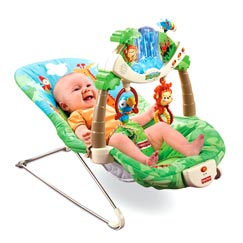WASHINGTON, D.C. – The U.S. Consumer Product Safety Commission (CPSC) approved a new federal mandatory standard to improve the safety of infant bouncer seats and prevent deaths and injuries to babies.
Infant bouncer seats support babies in a reclined position and allow them to bounce. This durable infant product is intended for infants up to 6 months old who have not developed the ability to sit up unassisted.
The new federal standard is based on the existing voluntary standard, ASTM F2167-17. The ASTM standard improved the requirements for stability to address tip-over incidents and for the battery compartment to address incidents involving battery leakage, corrosion, and overheating.
The Commission’s more stringent requirements are intended to further reduce the risk of serious head injuries associated with falls from elevated surfaces, such as tables and counter tops. The mandatory standard will make fall hazard warnings more visible to caregivers, by requiring the label to be placed on the front of the bouncer seat near the baby’s head and shoulders. Caregivers are also instructed to use restraints even if a baby falls asleep in the bouncer, which is a likely occurrence. More on the new mandatory standard can be found here.
Between January 1, 2006 and July 6, 2016, there were 347 incidents involving bouncer seats reported to CPSC, including 12 fatalities and 54 injuries. The major cause of reported fatalities was suffocation resulting from unrestrained babies turning over in a bouncer or bouncers tipping over on soft surfaces (e.g., mattresses and comforters) when bouncer is placed on adult beds and cribs. Additionally, the National Electronic Injury Surveillance System demonstrates 874 incidents involving bouncer seats from January 1, 2006 to December 31, 2015. The hazard patterns related to these incidents (485 of the 874) were mainly due to infants falling while in bouncers or from a bouncer placed in hazardous locations, such as kitchen countertops, tables and other elevated surfaces. Falls resulted in concussions and skull fracture to babies. These types of injuries can lead to brain damage and long-lasting health effects.
CPSC recommends the following tips to parents and caregivers when using an infant bouncer seat:
- Always use the bouncer on the floor, never on a countertop, table or other elevated surface.
- Never place the bouncer on a bed, sofa, or other soft surface because babies have suffocated when bouncers tipped over onto soft surfaces.
- Always use restraints and adjust restraints to fit snugly, even if baby falls asleep.
- Stay near and watch the baby during use.
- Stop using the bouncer when a child is able to sit up on his/her own or the baby reaches 20 lbs. or the manufacturer’s recommended maximum weight.
The Commission is required by The Danny Keysar Child Product Safety Notification Act, Section 104(b) of the Consumer Product Safety Improvement Act of 2008 (CPSIA), to issue consumer product safety standards for durable infant and toddler products. In the past seven years, the Commission has approved new federal safety standards for durable infant or toddler products, including full-size cribs, non-full-size cribs, play yards, baby walkers, baby bath seats, children’s portable bed rails, strollers, toddler beds, infant swings, handheld infant carriers, soft infant carriers, framed infant carriers, bassinets, cradles, portable hook-on chairs and infant slings.
The Commission voted 3-2 in favor of the new standard on September 1, 2017. Acting Chairman Buerkle and Commissioner Mohorovic voted to incorporate ASTM F2167-17 by reference.
The CPSC has proposed that the rule become effective 6 months after the publication of a final rule in the Federal Register.
About the U.S. CPSC
The U.S. Consumer Product Safety Commission (CPSC) is charged with protecting the public from unreasonable risk of injury associated with the use of thousands of types of consumer products. Deaths, injuries, and property damage from consumer product-related incidents cost the nation more than $1 trillion annually. Since the CPSC was established more than 50 years ago, it has worked to ensure the safety of consumer products, which has contributed to a decline in injuries associated with these products.
Federal law prohibits any person from selling products subject to a Commission ordered recall or a voluntary recall undertaken in consultation with the CPSC.
For lifesaving information:
- Visit CPSC.gov.
- Sign up to receive our email alerts.
- Follow us on Facebook, Instagram, X, BlueSky, Threads, LinkedIn and Truth Social.
- Report a dangerous product or a product-related injury on www.SaferProducts.gov.
- Call CPSC’s Hotline at 800-638-2772 (TTY 800-638-8270).
- Contact a media specialist.
Please use the below phone number for all media requests.
Phone: (301) 504-7908
Spanish: (301) 504-7800




